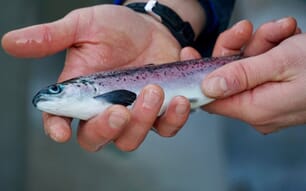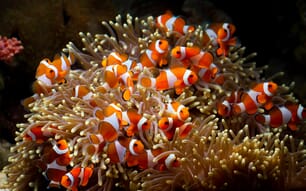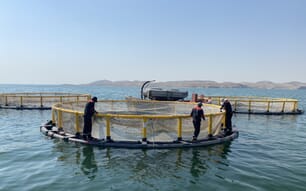Professor Goro Yoshizaki, a professor of marine biological resources at Tokyo University of Marine Science and Technology, spent his student days fishing for masu salmon and char in the late 1980s, the end of steep economic growth in Japan.
"Back then, the number of public works projects was increasing," he explained to me during a recent visit. "Highways and railways had been built and next on the list was dams. I would return to the rivers I used to fish at, only to find a series of dams. The fish had been blocked off and could no longer migrate. Things had really changed."
This, as well as issues like river pollution and the declining number of fish populations worldwide, spurred the professor on to begin his research. In November 2015, he successfully produced functional eggs and sperm derived from spermatogonia in whole rainbow trout that had been kept in a freezer.
The Professor and his team began by anesthetizing a male rainbow trout and preserving it for a year at minus 80°C without the aid of exogenous cryoprotectants. After thawing the fish, they removed the cells that produce sperm and transplanted them into the abdominal cavities of male and female masu salmon hatchlings. The sperm production cells migrated to the recipient gonads of the salmon where they were incorporated and multiplied rapidly as a result. Once the salmon reached sexual maturity, the eggs from the female salmon were fertilized with the sperm from the males. It was soon found that eggs and sperm obtained from the salmon recipients could produce donor-derived trout offspring.
"One of our graduate students found nearly 1,500 stem cells in a rainbow trout that were still alive even after a year of freezing, so we harvested the cells and transplanted them into the masu salmon. Two years later, they produced eggs and sperm," Professor Yoshizaki explained.
"But there was more. We already knew about the importance of slow freezing and cryoprotectants to successfully cryopreserve animal cells, but we also discovered that the fish's body mass acts as an insulator and makes it possible to slow freeze spermatogonia in the bodies of whole trout. While the body acts as an insulator, extracellular fluid surrounding the cells worked as a natural cryoprotectant, allowing the spermatogonia to remain viable even after the whole trout had been frozen."
This is not the only research the professor is known for. Back in 2013 he achieved a scientific breakthrough by coming up with a surrogate broodstock technology in which immature germ cells from a target fish species are transplanted into a closely related species, so that the surrogate can produce the eggs and sperm of the target species. He froze the testes of yamame salmon, a freshwater species indigenous to Japan and one of two varieties of masu salmon (a migratory and freshwater fish found in the Pacific Ocean along countries like Japan, Korea and Russia). The spermatogonia were extracted and implanted into sterile rainbow trout hatchlings. The hatchlings used the spermatogonia to develop functional sperm and viable eggs depending on their gender. The sperm and egg cells were then combined via in vitro fertilisation to produce healthy yamame salmon species.
Professor Yoshizaki's latest research could have two main impacts on aquaculture. The first is the preservation of valuable genetic resources. Keeping live broodstock can be risky due to the possibility of facility accidents, natural disasters in the case of Japan, a reduced fitness within natural habitats of individuals raised in captivity and outbreaks of infectious diseases. Slow freezing could help reduce such risks as endangered fish could be kept in deep freezers until specimens are sent to laboratories for spermatogonial transplantations. The second is the possibility of breeding bluefin tuna using small mackerel as a surrogate. Research is currently underway to achieve this.
Other sectors and countries have expressed a keen interest in Professor Yoshizaki's work. His technology is currently being used in amphibians to help endangered frogs and toads, while 150,000 tonnes of yellowtail, one of Japan's most important aquaculture species, has been successfully produced using horse mackerel as a surrogate. Referring to the popular but poisonous Japanese delicacy, the professor confirmed that his technology has been used on tiger puffer fish as well.
Interest from abroad has been high, with enquiries from Australia, Hungary and Brazil. Work is underway with a university in the US to preserve genetic resources of endangered native salmon, while a French group has successfully used the professor's technology in its laboratory.
"I'd like my work to be applied to more areas, mammals for example, not just fish," Professor Yoshizaki said. "But there is still a lot to do because the sets of genes are much more different between male and female mammals."
Professor Yoshizaki believes that preserving eggs and sperm through freezing has high potential as an alternative way of conserving endangered species. He is hoping to reach in vitro cell culture and eventually propagate cells indefinitely without using fish. But, what he really wants is to "save fish," and hopes that his work will play an even greater role.




